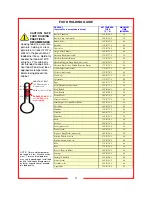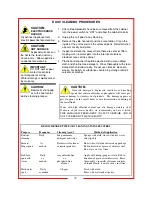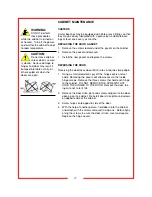
10
DAILY CLEANING PROCEDURES
1. After all food products have been removed from the cabinet,
turn the power switch to “OFF” and allow the cabinet to cool.
2. Unplug the unit prior to any cleaning.
3. Remove the side heat duct and rack assemblies. Clean the
inside of the unit as well as the removed parts. Reinstall when
all parts are dry and clean.
4.
Inspect and clean the areas where there are vents or filters,
making sure no water gets into the internal controls or
electrical areas of the cabinet.
5.
Plastic control panel should be washed with a clean damp
cloth and chlorine-free detergent. Rinse thoroughly with clean
damp cloth and allow to dry. Do not use abrasive cleaners,
waxes, car polish, or substances containing strong aromatic
solvents or alcohol.
RECOMMENDED TIPS FOR CLEANING STAINLESS STEEL
Purpose
Frequency
Cleaning Agent
Method of Application
Routine
Daily
Soap, ammonia
Sponge with cloth, rinse with clear water
cleaning
detergent
and
water
and
wipe
dry.
Smears/
As
Stainless steel cleaner
Rub with soft cloth as directed on package.
Fingerprints
needed
or similar products
Rub in direction of grain of stainless steel.
Do
not
use
on
vinyl
trim.
Stubborn
Daily
Any chloride-free
Apply with damp sponge or cloth. Rub in
spots and
as
or
direction of grain of stainless steel. Rinse
stains
needed
phosphate-free
thoroughly, especially if cleaner contains
cleaner
chlorine bleach, do not use on vinyl trim.
Hard water
Daily
Vinegar
Swab with cloth.
spots
as needed
Rinse with water and wipe dry.
CAUTION:
ELECTRIC SHOCK
HAZARD
Disconnect appliance from
electric power before cleaning.
CAUTION:
HOT SURFACE
Exposed surfaces can
be hot to the touch and may
cause burns. Allow appliance
to cool before cleaning.
IMPORTANT:
DO NOT spill or pour
water into controls,
control panel or wiring.
Water damage is
not
covered
by warranty.
CAUTION
:
Beware of sharp edg-
es with sheet metal
during cleaning process.
CAUTION:
Cleansers, detergents, degreasers, sanitizers, or bleaching
agents that contain chlorides or phosphates will cause per-
manent damage to stainless steel products. The damage appears as
pits, eruptions, voids, small holes, severe discoloration or dulling of
the metal finish.
Water with high chloride content can also damage stainless steel.
If unsure of your water quality, we recommend you have it tested.
THIS DAMAGE IS PERMANENT, COSTLY TO REPAIR, AND IS
NOT COVERED BY THE WARRANTY
.































